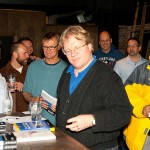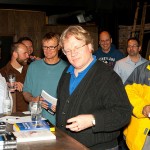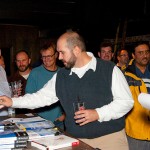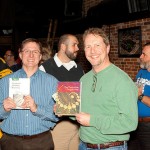Our meeting has moved away from the Tivoli for the month of July!
This month’s DJUG Meeting will be at the Tattered Cover Conference Center downtown.
Their address is 1628 16th St Denver CO 80202.Schedule:
5:30 – 6:00 PM Pizza and Networking
6:00 – 7:00 PM HTML5 Primer
7:00 – 7:10 PM Short break
7:10 – 7:15 PM Announcements
7:15 – 8:45 PM Ari Zilka – EhcacheFeatured Presentation: Ehcache
Abstract:
Ehcache is an open source, standards-based cache used in a wide array of applications to boost performance, offload the database and simplify scalability. Ehcache is robust and in use in thousands of mission-critical applications. It is the most widely used Java-based cache.
With the release of 2.0, you can use Ehcache to:
- Snap into Hibernate, OpenJPA, Eclipselink and offload the database 80% or cache direct JDBC responses from the database by hand
- Build the highest performance into your application using write-behind, ReadOnly views, NonStop caches, WAN replication, and more of the new enterprise-class features in the framework
- Monitor and tune your caches in production with JMX or your favorite monitoring tool like Nagios
You will learn:
- How to snap Ehcache into the latest Hibernate
- The differences between Ehcache, expensive data grids from companies like Oracle and IBM, and Memcached
- About the new Ehcache Monitor and how to use it
- About the detailed roadmap of Ehcache 2 through the rest of this year.
About the Speaker:
Ari is a frequent speaker at technical conferences, such as SpringOne, QCon, Devoxx, and JavaOne, where this year he accepted the 2009 Java Everywhere Duke’s Choice Award for Terracotta.
Before founding Terracotta in 2003, Ari was an Entrepreneur-in-Residence at Accel Partners. Before joining Accel, Ari was the Chief Architect at Walmart.com, where he led the innovation and development of the company’s new engineering initiatives. At Walmart.com, he built and led a team of core engineers focused on performance management, and operations cost-saving measures.
Prior to Walmart.com, Ari worked as a consultant at Sapient and before that at PriceWaterhouseCoopers. During these years, he managed development and advised businesses on high technology strategy and deployment. His accomplishments at Sapient include the successful launch of Walmart.com, as well as successful engagements with Gap.com and Nike.com. At PriceWaterhouseCoopers, he worked with Harrod’s of London, Siemens, Intel, Compaq, Barnes & Noble, and others.
Ari’s career started as a software engineer for a subsidiary of Motorola, where he wrote groundbreaking wireless paging software. Since then, his software development accomplishments also include projects revolving around statistical analysis and data warehousing. In the mid 1990’s, Ari invented a new object relational database that still exceeds the capabilities and performance of database technology today.
Ari holds a B.S. in Electrical Engineering Computer Science as well as in Mechanical Engineering from University of California, Berkeley.
Basic Concepts: HTML5 Primer
Frederic Jean’s slide deck can be found here: http://djug-html5.heroku.com/
Abstract:
HTML5 is already changing how web applications are written and delivered. It introduces new capabilities to the browser environment and simplifies some frequent tasks that face web developers. The need to continue supporting older browsers introduces some challenges in fully adopting HTML5.
We will discuss some of the new HTML tags, CSS rules and JavaScript API introduced by HTML5, what is currently supported by modern browsers and discuss some strategies on how to deal with older browsers.
About the Speaker:
Frederic Jean brings over 13 years of experience developing and supporting applications on the web. His current focus is on delivering online video to browsers and other devices using both native and HTML based user interfaces.
Sponsors
Room
Food
Meetup Page
Door Prizes
Hosting
Discounts-
Recent Posts
Archives
- December 2025
- November 2025
- September 2025
- July 2025
- May 2025
- April 2025
- March 2025
- February 2025
- December 2024
- November 2024
- October 2024
- August 2024
- July 2024
- June 2024
- May 2024
- March 2024
- February 2024
- January 2024
- October 2023
- September 2023
- August 2023
- July 2023
- May 2023
- March 2023
- February 2023
- January 2023
- December 2022
- November 2022
- October 2022
- September 2022
- July 2022
- May 2022
- March 2022
- February 2022
- January 2022
- November 2021
- October 2021
- September 2021
- August 2021
- June 2021
- May 2021
- April 2021
- February 2021
- January 2021
- October 2020
- August 2020
- July 2020
- June 2020
- May 2020
- April 2020
- February 2020
- February 2019
- January 2019
- December 2018
- November 2018
- October 2018
- September 2018
- August 2018
- July 2018
- June 2018
- May 2018
- April 2018
- March 2018
- January 2018
- December 2017
- October 2017
- September 2017
- July 2017
- June 2017
- May 2017
- March 2017
- January 2017
- December 2016
- October 2016
- August 2016
- July 2016
- June 2016
- May 2016
- April 2016
- February 2016
- January 2016
- December 2015
- November 2015
- October 2015
- September 2015
- August 2015
- July 2015
- June 2015
- May 2015
- April 2015
- March 2015
- February 2015
- January 2015
- December 2014
- November 2014
- October 2014
- September 2014
- August 2014
- July 2014
- April 2014
- February 2014
- November 2013
- June 2013
- May 2013
- April 2013
- March 2013
- February 2013
- January 2013
- November 2012
- October 2012
- September 2012
- August 2012
- July 2012
- June 2012
- May 2012
- April 2012
- March 2012
- February 2012
- December 2011
- November 2011
- October 2011
- September 2011
- August 2011
- July 2011
- June 2011
- May 2011
- April 2011
- March 2011
- February 2011
- January 2011
- December 2010
- November 2010
- October 2010
- September 2010
- August 2010
- July 2010
- June 2010
- May 2010
- April 2010
- March 2010
- February 2010
- January 2010
- November 2009
- October 2009
Categories
Meta



























